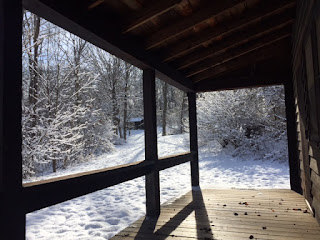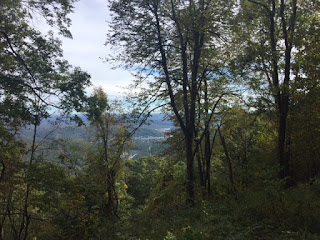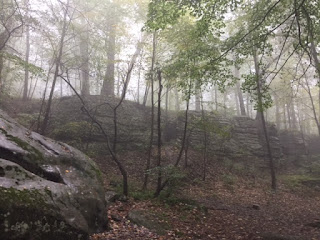As we waited for the school bus this morning on the cold front porch, my eleven year old daughter and I discussed the things we like about winter. There are several: the way a blanket of snow muffles all noise; the way snow light glows as if it's coming from everywhere, even on an overcast day; the silence of the winter woods; the cozy feeling of "nesting" when the weather outside is cold.
I was inspired by the "nesting" theme. And since I didn't have time today for a long trek, I decided to return to Raccoon Creek to look for places suitable for a homeless person to hide out for the winter--or nest. Since I just told you that I have a front porch, naturally I'm not homeless. But things are going to get weird in Trump's America. The unthinkable is going to happen in more ways than one. Besides, I've been making my homelessness plan for years. Take a look at this nice little one-room cabin in a remote section of the park that remains snowbound much of the winter.
Of course, the editorial board at S&J in no way condones or promulgates any illegal activity like squatting. But if you were really desperate and didn't want to be an urban homeless person, what about a sylvan alternative? You might head out here in late November, after this whole section of the park has been closed down for the season, and you go nocturnal. You move into this one-room cabin (about 20 feet by 12), and you sleep during the day. Why? In order to stay warm. You spend the daylight hours all bundled up in your sleeping bag and whatever cocoon-like materials you can smuggle into the cabin, like a warm cardboard box the size of a coffin. And at night? At night you light a fire in the fireplace, and you cook, and read, and exercise, and eat, and write letters, and do origami... When the morning light touches the sky with the first hints of gray, you go back to bed.
This particular cabin wasn't built for winter weather. Despite the nice fireplace and solid glass windows, the clapboard walls have no insulation or plaster. It would get right cold indeed. But you'd have a nice porch. And it would be better than a park bench.
That cabin is back in Group Camp # 3--which is an area that non-profit groups can rent in the summer. In a less sequestered spot, there are cabins that are rented out to individuals and families. Near the entrance to this "modern cabin rental area," there are two large, old cabins that have always caught my eye. Their all-weather walls make them a better choice for wintering, and though they're in a heavily used, year-round area, the sit off by themselves. The architectural style would suggest that they were built in 1930s by the CCC, which is how the park got started. I've long been curious about them; they look grand and welcoming from the outside--set down a little embankment from the cabin loop road with broad, sloping lawns and back porches toward the forest.
The first one I approached turned out to be a shell with nothing remaining inside. Even the walls between the rooms had all been broken down. But the second cabin (pictured in the above photo and all the below photos) had blinds pulled shut in all the windows, which made me think it was still in use. The back door was unlocked, but the floor beneath it had buckled so badly that it was very hard to open. This is what I found inside. Some critter tore the stuffing out of this old recliner, the only bit of furniture left in the cabin.
There were two bedrooms, a large bathroom, a kitchen (below), and the living room with the fireplace and recliner. The floors looked unreliable in some spots, and the whole place stank of mold. Judging by the style of the light fixtures, the ceiling fans, and other accouterments, I'd say the place was still being rented out in the 1990s.
It's a slightly creepier option for wintering, and a lot closer to the year-round modern cabins, so you're more likely to get caught. But it would definitely hold heat better. With a lot of broom work, it just might be sufficient shelter for a cold season in the woods. Again, not advocating for any illegal activity, just a thought...


















































